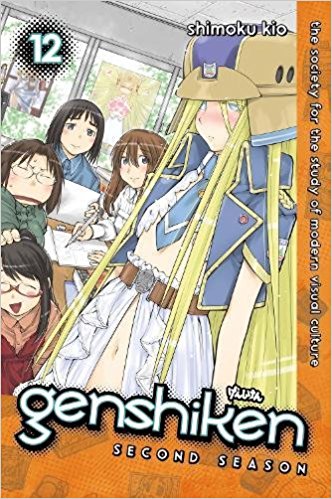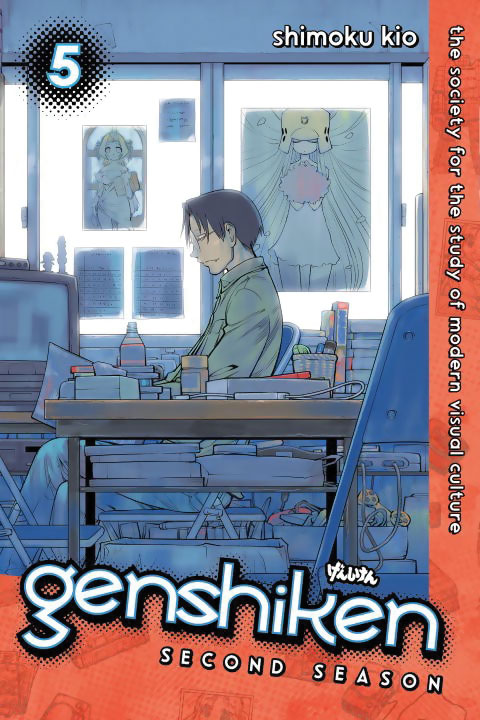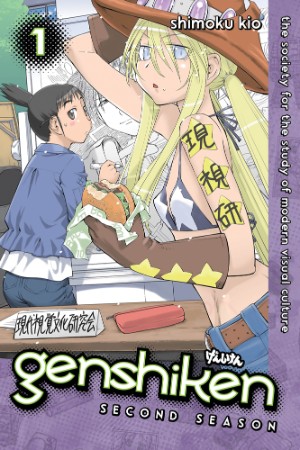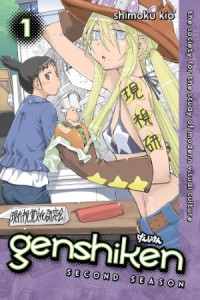By Shimoku Kio. Released in Japan by Kodansha, serialized in the magazine Afternoon. Released in North America by Kodansha Comics. Translated by Stephen Paul.
The last time I gave Genshiken a full review, I noted that the author seemed to be aiming for a new demographic with the new cast being mostly women, and their own interests tending towards BL. Well, we’ve had several volumes since then, and I’d say in the end the demographic didn’t QUITE change. Genshiken is still, at heart, a series for male otaku by a male otaku. But I think the Second Season may have helped broaden their horizons a bit, showing the readers what life is like outside their comfort zone, particularly with the awkward, touching but ultimately “just friends” relationship between Madarame and Hato. That said, I suspect that readers over here in North America may have wished that he’d pushed the envelope a bit more – the final half of this sequel was all about Madarame in a harem situation, something that aggravated as many people as it entertained. Still, at least it avoided the dreaded “nothing changes” stasis, mostly thanks to Saki, who makes one last appearance to kick Madarame’s ass into gear.
The cover art may give you an idea of who the Final Girl is, but honestly it was easy to figure out with Madarame’s rejection of all four, which had three sensible, well-thought out replies and one lame dodge, something Saki immediately points out. (Amusingly, everyone else there noticed it as well, but weren’t saying anything – Madarame can be appallingly stubborn, and only Saki can kick back against that.) And despite confessing to each other in otaku terms – or perhaps because of it – Madarame and Sue do actually make a very good couple, though actual coupling may still be a long way off. It’s also nice to see Madarame distancing himself from the Genshiken, moving away and trying once again to find a real job. The Genshiken has always been filled with weirdos, but Madarame vs. Saki had been the plot for so long that it was nice to see it return for one final appearance.
And then there’s graduation. I could talk about Kuchiki here, but don’t want to, despite the fact that the end of the book is mostly about him. Instead, let’s talk about Hato, who Madarame rejects here with a very well-thought out reason – he doesn’t think Hato is comfortable enough in his own skin to date a guy, and thinks that he should concentrate on being a “fudanshi” who likes to cross dress. The series has been dancing back and forth on Hato’s gender identity and sexual preferences, and again, I don’t think that the author goes as far as the audience wanted him to take it. That said, the journey we’ve seen in the last 12 volumes has been fantastic in many places, and Hato is absolutely the most interesting character in the sequel, with Yajima a close second. (Fans of Hato may be interested in checking out Spotted Flower, an unlicensed “alternate universe” Genshiken manga, though I warn fans of Genshiken proper that they may not like it.)
Like a lot of otaku-driven anime and manga, Genshiken went on too long, added some unnecessary subplots, and features far too much of characters that everyone hates – both in universe and out. But the journey had some wonderful moments, and in the end I think was worth it, even if it ended up more breaking down than reaching its goal. I wish the cast well.





